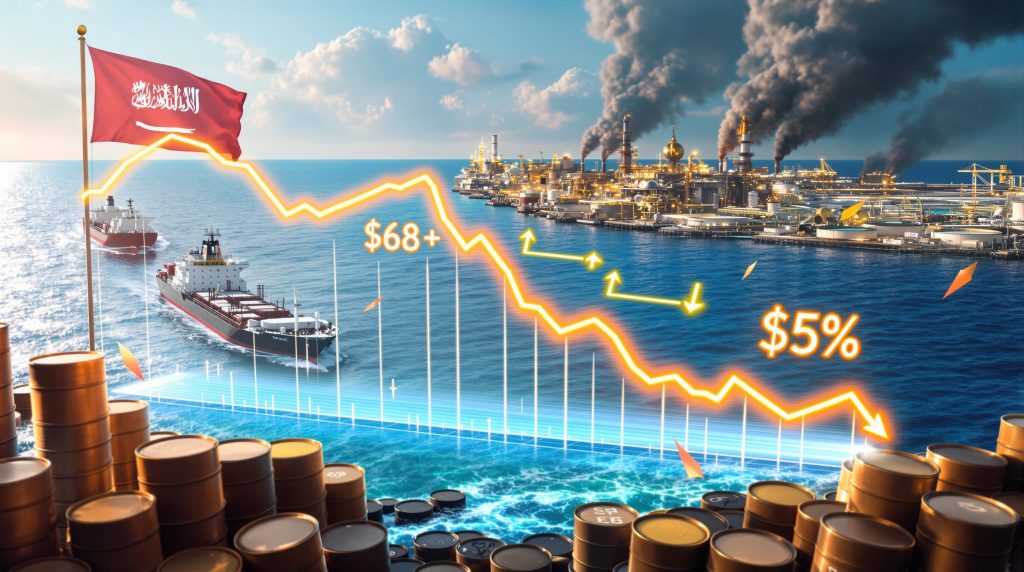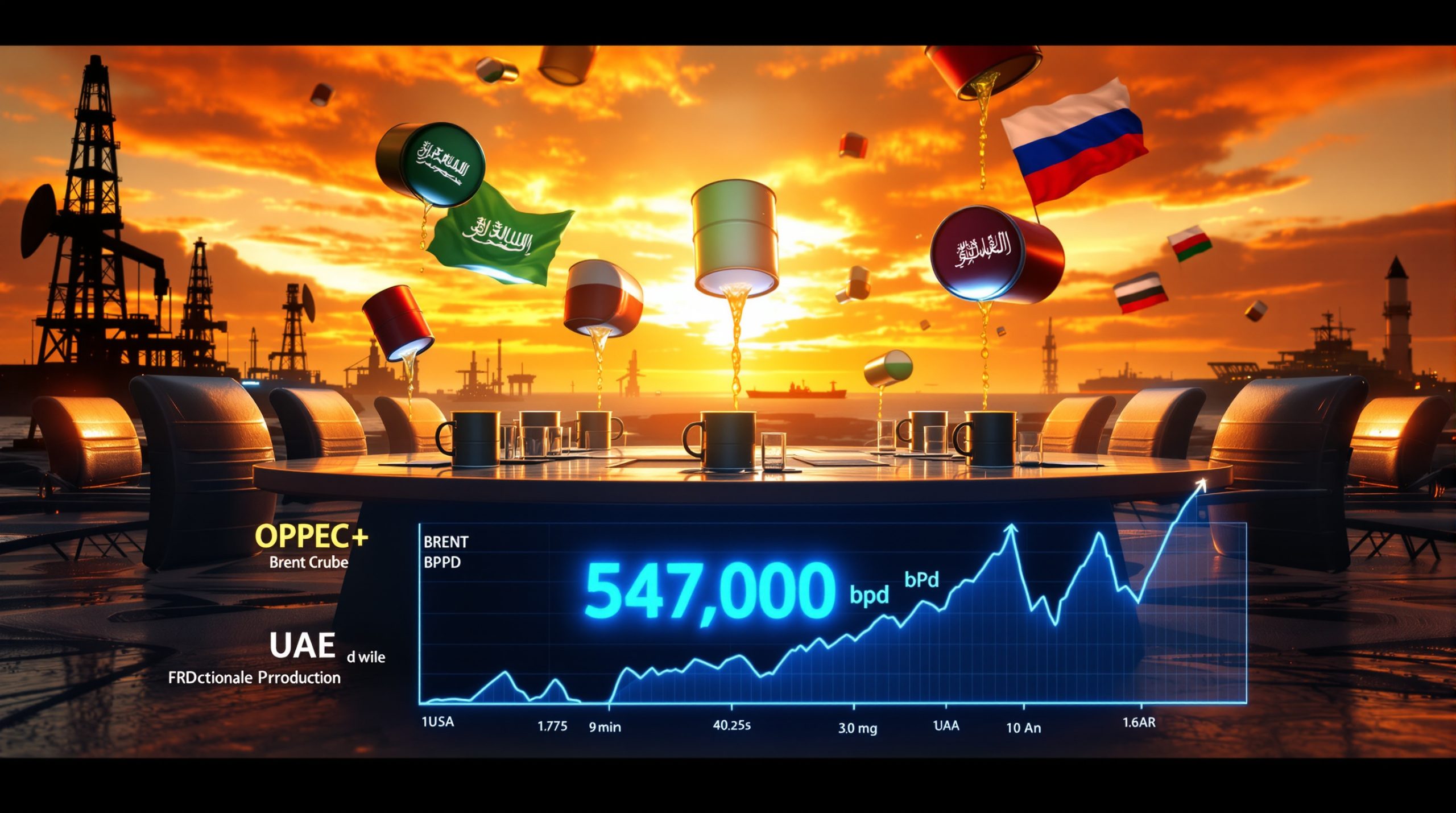OPEC+ Oil Production Hike: Impact, Strategy, and Market Implications
OPEC+ has announced a significant oil production increase of approximately 548,000 barrels per day (bpd) starting September 2024. This decision marks the latest step in the alliance's strategy to gradually unwind voluntary supply cuts implemented in late 2023 and early 2024. The move comes amid evolving market conditions and shifting priorities among key oil-producing nations.
The September increase follows a pattern of accelerating production hikes throughout 2024, beginning with 138,000 bpd in April and growing to over 400,000 bpd in subsequent months. This progression demonstrates OPEC+'s calculated approach to reintroducing supply to the global market.
Key Factors Behind the Production Increase
-
Strategic Unwinding: The September hike is part of a broader plan to phase out approximately 2.2 million bpd of voluntary cuts, though OPEC+ still maintains other production restrictions totaling about 3.66 million bpd.
-
Market Share Considerations: Growing concerns about maintaining relevance in an increasingly competitive global oil landscape have pushed OPEC+ to reconsider its supply strategy.
-
Economic Pressures: Budget requirements of member countries are necessitating higher production volumes despite potentially lower prices, as fiscal constraints grow more pressing.
-
Demand Signals: Adjustments are being made in response to post-summer seasonal patterns and economic indicators showing moderate growth in key consumption regions.
How Will This Production Hike Affect Oil Prices?
The market has responded cautiously to the announcement, with analysts projecting significant price implications. Current forecasts suggest Brent crude prices could decline from approximately $68 per barrel to between $50-$59 per barrel in the coming months.
According to market experts at JP Morgan, "The decision to increase production signals OPEC+'s willingness to accept lower prices to maintain market share, potentially causing a period of price weakness through early 2025."
Price Impact Factors
| Factor | Short-term Effect | Long-term Projection |
|---|---|---|
| Increased Supply | Immediate downward pressure | Potential market rebalancing by Q2 2025 |
| Demand Growth | Moderate seasonal support | Uncertain due to economic headwinds |
| Inventory Levels | Building inventories | Potential oversupply concerns |
| Production Compliance | Varied adherence to quotas | May necessitate policy adjustments |
The production increase signals OPEC+'s willingness to accept lower price points, potentially as a disciplinary measure for members exceeding quotas and as a strategy to maintain market share against non-OPEC producers like the United States and Brazil.
Who Are the Key Players Driving OPEC+ Decisions?
The alliance's decision-making process reveals the significant influence of certain member nations, with power dynamics continuing to shape production policies.
Influential OPEC+ Members
-
Saudi Arabia: As the dominant OPEC member, Saudi Arabia maintains substantial spare capacity of approximately 3 million bpd and often leads production policy direction. Energy Minister Prince Abdulaziz bin Salman has emphasized the kingdom's role as a "responsible producer."
-
Russia: A critical non-OPEC partner with significant production capabilities exceeding 10 million bpd and strategic interests that occasionally diverge from Gulf producers.
-
United Arab Emirates: Has secured permission to increase output by an additional 300,000 bpd beyond its previous quota, reflecting its growing influence and ambitious capacity expansion plans.
-
Iraq and Kuwait: Middle-tier producers with significant production capacity but varying degrees of compliance with quotas, creating tension within the alliance.
Bank of America analysts noted that "The dynamics within OPEC+ are increasingly complex, with traditional power centers being challenged by members seeking to maximize their market position."
What Does This Mean for Global Oil Supply and Demand Balance?
The September production increase occurs against a backdrop of complex supply and demand dynamics that will shape market conditions through 2025.
Supply-Demand Implications
-
Inventory Projections: Industry analysts anticipate inventory builds through late 2024 into early 2025, potentially creating downward price pressure as storage levels increase above five-year averages.
-
Demand Concerns: Economic growth uncertainties in key markets like China, where manufacturing activity has shown signs of slowing, raise questions about absorption capacity for additional barrels.
-
Non-OPEC Production: Continued output growth from producers outside the alliance, particularly in the United States, Brazil, and Guyana, complicates market balancing efforts with combined growth of approximately 1.1 million bpd expected.
-
Seasonal Factors: Winter heating demand may partially offset supply increases in Northern Hemisphere markets, providing some price support during the fourth quarter.
The International Energy Agency (IEA) has projected global oil demand growth of 1 million bpd for 2024, which is significantly lower than previous forecasts and insufficient to absorb both OPEC+ increases and non-OPEC supply growth.
How Are Different Countries Affected by OPEC+'s Decision?
The production increase creates varied impacts across both oil-producing and oil-consuming nations worldwide.
Impact on Producer Countries
-
High-Cost Producers: Nations with higher production costs, such as offshore producers and those with aging fields, face increased pressure from potentially lower prices, threatening project economics.
-
Budget-Dependent Exporters: Countries heavily reliant on oil revenues for fiscal stability, including Nigeria, Angola, and Iraq, may experience budgetary challenges if prices decline significantly below their fiscal breakeven points.
-
Diversified Economies: Oil producers with more diversified economic structures, like the UAE and Saudi Arabia, can better withstand price fluctuations through their sovereign wealth funds and economic reform programs.
Impact on Consumer Countries
-
Major Importers: Nations like China, India, and Japan may benefit from potentially lower energy costs, supporting manufacturing sectors and reducing inflationary pressures.
-
Emerging Markets: Developing economies could see reduced energy import bills, supporting economic growth and currency stability in regions highly sensitive to energy costs.
-
Strategic Reserves: Countries may adjust strategic petroleum reserve policies in response to changing market conditions, with some potentially taking advantage of lower prices to rebuild stockpiles.
According to Citigroup's commodities research team, "The price moderation from increased OPEC+ supply could provide a modest economic stimulus to oil-importing nations, particularly in Asia where energy demand growth remains most robust."
What Are the Long-Term Strategic Implications?
Beyond immediate market effects, OPEC+'s production decision reflects broader strategic considerations about the alliance's future role in global energy markets.
Strategic Dimensions
-
Market Share Defense: Increasing production may represent a defensive move to maintain relevance amid growing competition from both conventional and unconventional producers outside the alliance.
-
Internal Cohesion: The decision tests the alliance's ability to maintain unity despite potentially divergent member interests, with compliance likely becoming a more contentious issue.
-
Energy Transition Positioning: The move may reflect recognition of the need to monetize hydrocarbon resources amid accelerating global energy transitions, with many analysts projecting peak oil demand within the next decade.
-
Geopolitical Signaling: Production increases send messages to both consuming nations and non-OPEC producers about market intentions and the alliance's willingness to defend its market position.
Goldman Sachs analysts observed that "OPEC+ appears to be shifting from a strategy of price defense to one of market share preservation, acknowledging the structural challenges posed by the energy transition and non-OPEC supply growth."
How Might OPEC+ Adjust Its Strategy Going Forward?
The September production increase represents one step in an evolving strategy that may require further adjustments based on market responses and economic conditions.
Potential Future Scenarios
-
Continued Unwinding: Further gradual increases in production if market conditions support, potentially completing the reversal of voluntary cuts by mid-2025.
-
Strategic Pause: Potential holding pattern to assess market impact before additional changes, particularly if prices decline sharply or inventories build rapidly.
-
Responsive Adjustments: Possible production pullbacks if prices fall below acceptable thresholds, with $50 per barrel often cited as a key psychological level for many producers.
-
Quota Enforcement: Increased focus on compliance among members exceeding production limits, potentially through more frequent ministerial meetings or enhanced monitoring mechanisms.
OPEC+ has demonstrated adaptability in the past, with over 30 policy adjustments since its formation in 2016, and market observers anticipate continued tactical adjustments as conditions evolve.
What Does This Mean for Energy Markets in 2025?
Looking ahead, the production increase sets the stage for potentially significant market developments in the coming year.
2025 Market Outlook
-
Price Projections: Current forecasts from major investment banks suggest sustained lower price levels through early 2025 unless demand significantly accelerates or supply disruptions occur.
-
Inventory Dynamics: Building global inventories could create extended price pressures without production adjustments, with commercial stocks potentially exceeding five-year averages by 150-200 million barrels.
-
Investment Implications: Potentially lower prices may impact capital allocation decisions for future production capacity, particularly for projects with higher breakeven costs above $60 per barrel.
-
Demand Recovery Questions: Uncertainty remains about the pace and extent of global oil demand growth, with transport electrification and efficiency gains potentially offsetting economic expansion in emerging markets.
Morgan Stanley's commodities research indicates that "The market is entering a testing period where supply growth may outpace demand recovery, creating a challenging price environment through at least the first half of 2025." This economic situation could potentially trigger a 2025 oil price crash if market fundamentals continue to deteriorate.
FAQ: OPEC+ Production Increase
How much oil is OPEC+ adding to the market in September 2024?
OPEC+ will increase production by approximately 548,000 barrels per day starting in September 2024, continuing the phased unwinding of voluntary cuts implemented in late 2023 and early 2024.
Why is OPEC+ increasing production despite forecasts of lower prices?
The alliance appears to be prioritizing market share and volume considerations over price maximization, potentially as a strategy to maintain relevance amid competition from non-OPEC producers and to discipline members exceeding quotas.
How does this production increase compare to previous adjustments?
The September increase represents an acceleration of the unwinding process that began with 138,000 bpd in April 2024 and has progressively increased through the year, reflecting a calculated approach to reintroducing supply.
What production cuts remain in place after this increase?
Even after the September increase, OPEC+ still maintains production restrictions totaling approximately 3.66 million bpd from various agreements, indicating the alliance retains significant supply management capacity.
How might this decision affect global inflation and economic growth?
Lower oil prices resulting from increased production could help moderate inflation pressures in oil-importing nations, potentially supporting economic growth in those countries while creating challenges for oil-dependent economies.
Further Exploration
Readers interested in learning more about global oil market dynamics can also explore related educational content available through energy information resources such as the U.S. Energy Information Administration and the International Energy Agency, which provide regular updates on global oil supply and demand balances.
The production decisions made by OPEC+ will continue to play a crucial role in global energy markets throughout 2024 and 2025, influencing everything from consumer fuel prices to investment decisions in the broader energy sector. These decisions also impact the ongoing oil price trade war dynamics and have significant tariff economic impacts globally.
Furthermore, the OPEC+ production hike occurs against a backdrop of declining US drilling activity, which adds another layer of complexity to global supply dynamics. Additionally, US-China oil tensions continue to influence market sentiment and could potentially amplify the effects of OPEC+'s production decisions in the coming months.
Looking to Invest in the Next Major Mineral Discovery?
Stay ahead of the market with Discovery Alert's proprietary Discovery IQ model, which instantly notifies investors of significant ASX mineral discoveries and transforms complex data into actionable insights. Understand why historic discoveries can generate substantial returns by visiting Discovery Alert's dedicated discoveries page.




